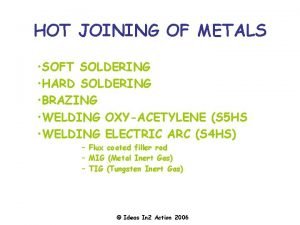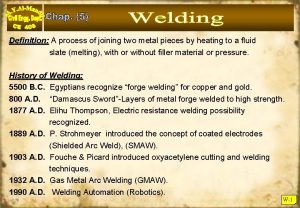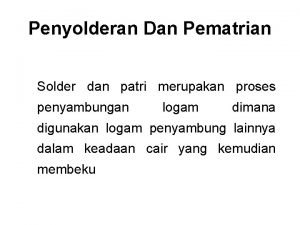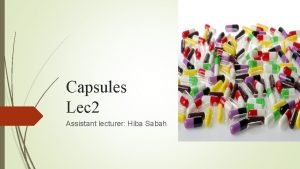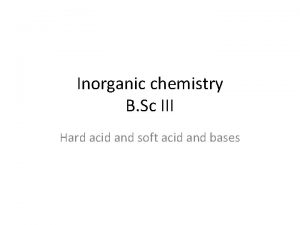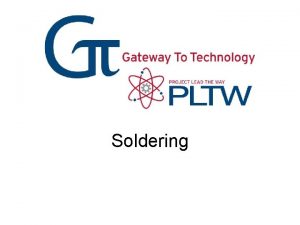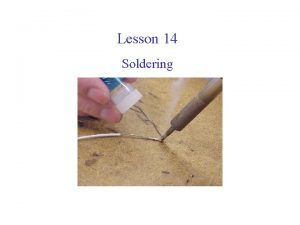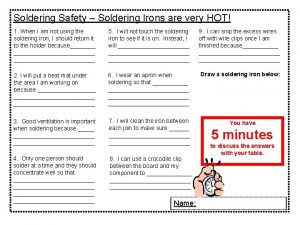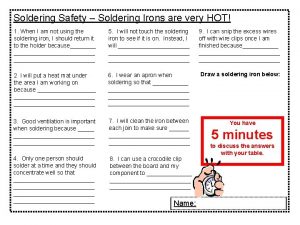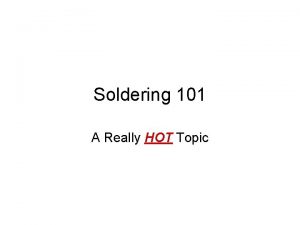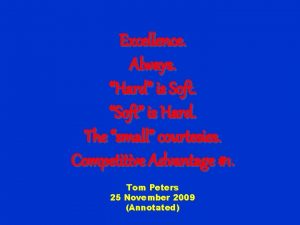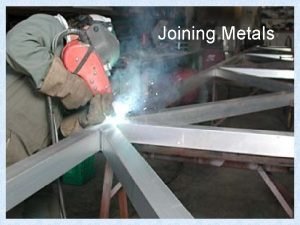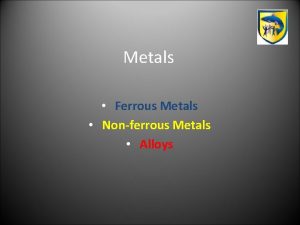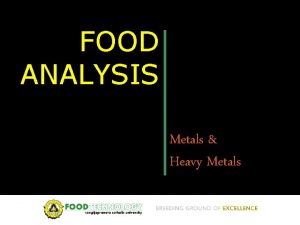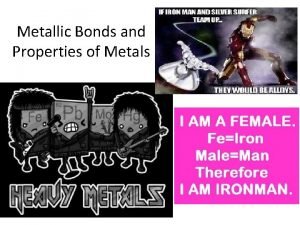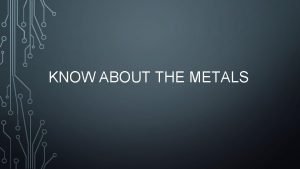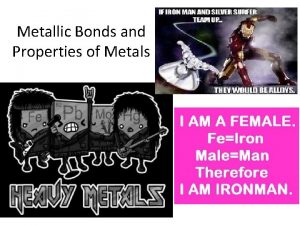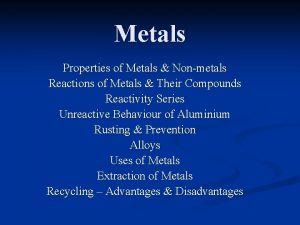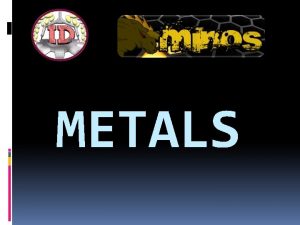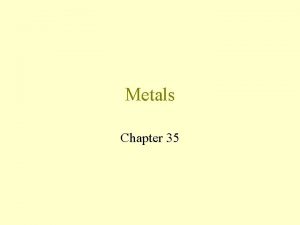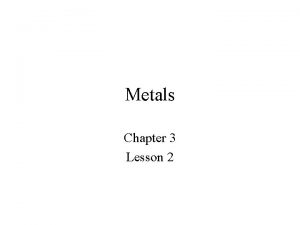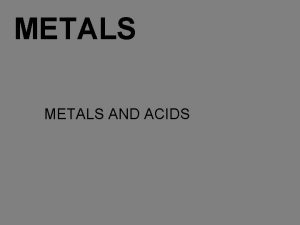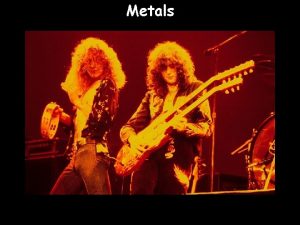HOT JOINING OF METALS SOFT SOLDERING HARD SOLDERING




















- Slides: 20

HOT JOINING OF METALS • SOFT SOLDERING • HARD SOLDERING • BRAZING • WELDING OXY-ACETYLENE (S 5 HS • WELDING ELECTRIC ARC (S 4 HS) – Flux coated filler rod – MIG (Metal Inert Gas) – TIG (Tungsten Inert Gas) © Ideas In 2 Action 2006

Soft soldering • Soft soldering is a quick method of joining most metals such as copper, brass, tinplate and steel. An exception is aluminium. • The process is best confined to light fabrication where joints are not subjected to heat and vibration and so do not need to be very strong. • Soft solder is an alloy made from varying proportions of tin and lead with antimony. • The melting point varies according to composition, ranging from 183 to 250 degrees Centigrade. • The solder used for electronics contains more tin than lead, making it flow more easily at a lower temperature. • The solder for tinplate or plumbing copper water pipes contains more lead than tin. It melts at a higher temperature and sets harder. © Ideas In 2 Action 2006

• • • Soft soldering fluxes Fluxes, available as liquids, powders or pastes, have been specially developed to protect the cleaned surfaces from oxidisation during heating; solders only stick to clean metal. The flux also helps the molten solder to flow freely by breaking down surface tension. Active fluxes (e. g. bakers’ flux) contain zinc chloride which chemically clean the surfaces. However, it is highly corrosive and must be washed off immediately upon completion. Passive flux are non-corrosive, but they only protect and do not actually clean. an example is the multi-core solder used in electronics, which has cores of resin flux running throughout its length. © Ideas In 2 Action 2006

Joining Process In preparation for soldering the joint surfaces must be clean. Use a suitable abrasive (e. g. emery cloth or steel wool) and avoid touching the area. In the joining process close-fitting joints are essential to ensure that the capillary action unites the surfaces. • A good solder joint depends on – A clean surface, – the correct flux – appropriate heat © Ideas In 2 Action 2006

Joining Process There are several ways of applying the necessary heat and solder. An electric soldering iron is cleaned, while hot, using a wet sponge and then ‘tinned’ with a thin film of solder. Or the joint is sweated, by tinning both parts of the joint first. © Ideas In 2 Action 2006

Hard soldering • Hard soldering is much stronger than soft soldering and requires higher temperatures. • Soft solders melt at around 200 degrees C, whereas the lowest melting point of hard solder is 625 degrees C. • The principle of local alloying and using a flux remains the same. • The extra heat requirement is supplied by using a gas/air torch. © Ideas In 2 Action 2006

Silver soldering • • Silver soldering is so called because hard solder contains silver alloyed with copper and zinc, giving melting points ranging from 625 to 800 degrees Centigrade. It enables work to be joined in several stages, – first using solder with a high melting point, – working through lower melting points – to finally the lowest, called ‘easy-flo’. This avoids the risk of earlier joints coming apart when applying heat for the later ones. © Ideas In 2 Action 2006

Joint Preparation • Proper joint preparation is important and thorough cleaning is necessary with the application of an active flux cramping the work with soft binding wire. • A special easy-flo’ flux is used for the lowest melting silver solder, whilst medium and hard grade solders use a borax flux (‘Tenacity’). © Ideas In 2 Action 2006

Soldering the joint • Pre-heat the joint with a gentle flame, then concentrate to a small hot flame to achieve a dull red heat. Solder flows to the hottest part, following the flame along the line of the joint. © Ideas In 2 Action 2006

Brazing • Brazing is a technique similar to soldering, except that considerably higher temperatures are needed. • Brazing spelter is an alloy of copper and zinc (brass) and melts in the range 870— 880 degrees Centigrade. This results in a much stronger joint, since brass is stronger than solder. • An air blown (brazing) gas torch is needed to maintain a hot flame. This does create a limiting factor, making it too hot to use with brass and copper, but it is ideal for mild steel. © Ideas In 2 Action 2006

Joint Preparation • Joints do benefit from interlocking, but they should all be wired or held securely to allow for expansion during heating. Use a flux with borax or a proprietary brand like ‘Sift bronze. ’ © Ideas In 2 Action 2006

Hints for hard soldering • The joint area must be thoroughly clean and fluxed. • Allow time for spelter or solder to flow, melting on the hot metal (not in the flame). • Pre-heat gently, avoid too fierce a flame which might blow away flux and spelter or solder. • Surround with fire-bricks to reflect all possible applied heat. • Heavy sections will require the most heat, at least to dull red. • Maintain the heat on the join, until the spelter or solder flows throughout the joint. © Ideas In 2 Action 2006

Welding • Welding offers a permanent method of fastening and fabricating products from a wide range of materials. Welding is the joining of two materials (usually metal) in their liquid form which solidifies and fuses together to form a joint that is as strong as the parent metal. • Industrially there are many ways of achieving this fusion. • Within school workshops two basic methods of welding metal are possible: oxyacetylene and electric arc. Health and safety references • COSHH Regs -1. 021 -1. 022 -1. 023 -1. 024 • BS 4163 2000 -Pages 40 - 41 © Ideas In 2 Action 2006

Types of welding processes Oxy-acetylene welding uses a mixture of the two gasses to produce a very hot flame (35000 C) that is used to melt the metal. The molten pool is moved along the joint line and additional material is introduced to it from a filler rod of the same metal. Electric arc welding makes use of a flux coated filler rod that acts as an electrode. A low voltage, high electrical current is struck between the electrode rod and the workpiece. The heat produced by the resulting electric arc melts both the rod and the material to be joined. The rod acts as a filler for the joint and so is consumed in the welding process. Metal Inert Gas (MIG) welding is another electric arc welding process. In this instance a continuous wire electrode is fed from a coil through the welding torch. The process is shielded by an inert gas enabling it to be used for aluminium welding. MIG welding has developed into a very controllable process and is now one of the most popular applications for robots. © Ideas In 2 Action 2006

Oxy-acetylene welding • In oxy-acetylene welding a heat source of around 3500 degrees C is produced by burning acetylene gas in oxygen. • Fine adjustment to the ratio of gases is made on the hand-held blowpipe. • Excess oxygen gives the hottest flame, but a neutral flame, with equal volumes of gas, is the most widely used. • Adjustments are made to suit the thickness and type of metal being welded. © Ideas In 2 Action 2006

The Process • During the welding process a pool of molten metal is created. • A filler rod, of the same metal as that being joined, is dipped into this and melts, filling the joint. • Fluxes are used with some materials, but not steels. © Ideas In 2 Action 2006

• • • Electric arc welding In electric arc welding an electric arc, of low voltage but high current of 10— 120 amps, is struck between a metal electrode and the material to be joined. The electrode, as well as carrying current, is a flux-coated filler rod. Very intense heat is produced at the end of the arc, melting the electrode and the metals to be joined to form the weld bead. Protection from oxidation is given by the special flux. This generates a gaseous shield, forming a molten blanket over the weld pool. As it solidifies a brittle glassy slag is formed, which can be easily chipped away when cold. Different metal thicknesses require different diameters of electrode and different currents. This process is widely used because of its low capital and running costs. © Ideas In 2 Action 2006

PREPARATION OF JOINTS To prepare the joints, paint, rust and any galvanised (zinc) coating must be removed. Thicker metal requires edge treatment such as bevelling, so that the weld achieves strength by penetration into the metal. © Ideas In 2 Action 2006

The electric arc welding process • SPECIAL EYE SHIELDING OR VISORS ARE COMPULSORY • LEATHER APRON SHOULD BE WORN • LEATHERGLOVES SHOULD BE WORN • WORK SHOULD BE CARRIED OUT IN A SHIELDED BOOTH AWAY FROMANY OBSERVERS © Ideas In 2 Action 2006

INDUSTRIAL APPLICATION • Spot welding is used commercially to give intermittent welds and some pre-tacking may be necessary with long runs. • Aluminium is an important material but is difficult to work because of its oxide film. MIG (metal inert gas) and TIG (tungsten’ inert ~gas) are processes used for welding aluminium. © Ideas In 2 Action 2006
 What is soft soldering and hard soldering
What is soft soldering and hard soldering Process of joining two metals
Process of joining two metals Sambungan patri lunak
Sambungan patri lunak Grade 7 natural science separating mixtures
Grade 7 natural science separating mixtures Metals and non metals in the periodic table
Metals and non metals in the periodic table Social science grade 7 term 2
Social science grade 7 term 2 Examples of alloy metals
Examples of alloy metals Reactivity in periodic table
Reactivity in periodic table Density of metalloids
Density of metalloids Hot working
Hot working Soft heart quotes
Soft heart quotes Minim/gram factor for soft gelatin capsules
Minim/gram factor for soft gelatin capsules Factors necessary for service standards are
Factors necessary for service standards are What are hard news
What are hard news Distinguish between soft and hard magnetic materials
Distinguish between soft and hard magnetic materials Scholar
Scholar Is inorganic chemistry hard
Is inorganic chemistry hard Springy end feel
Springy end feel Hard endpoint vs soft endpoint
Hard endpoint vs soft endpoint Conclusion soft skills
Conclusion soft skills Hard tooling vs soft tooling
Hard tooling vs soft tooling
